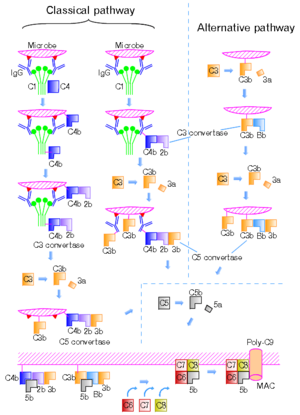Complement system facts for kids
Imagine your body has a special team of tiny helpers that fight off invaders like germs. This team is called the complement system. It works with other parts of your body's defense system, like antibodies and special "eating" cells called phagocytes, to get rid of harmful pathogens (which are like tiny enemies such as bacteria or viruses).
The complement system is a key part of your innate immune system, which is your body's first and fastest line of defense against sickness.
Contents
What is the Complement System?
The complement system is made of many small proteins. These proteins are found in your blood and are produced by your liver. Normally, they float around in your body in an inactive, "sleeping" state. Think of them like tiny, unactivated defense robots waiting for a signal.
How Does the Complement System Work?
When a harmful invader, like a bacterium, enters your body, it acts as a trigger. This trigger "wakes up" some of the sleeping complement proteins. Once awake, these proteins become active and start a chain reaction.
The Chain Reaction
When the first proteins are activated, they act like tiny scissors called proteases. These "scissors" cut other specific complement proteins. When these proteins are cut, they release active chemical messengers called cytokines.
This starts a series of events, like a row of dominoes falling. Each activated protein helps activate many more. This process is called a cascade. It makes the body's defense response much bigger and stronger very quickly. This is called "amplification."
Destroying Invaders
If the original trigger was an invading bacterium, the activated complement proteins work together to attack it. They can create tiny holes in the cell membrane of the bacterium. The cell membrane is like the outer skin of the bacterium. When holes are made, the bacterium can't survive and dies. This helps to clear the infection from your body.
Images for kids
See also
 In Spanish: Sistema del complemento para niños
In Spanish: Sistema del complemento para niños




